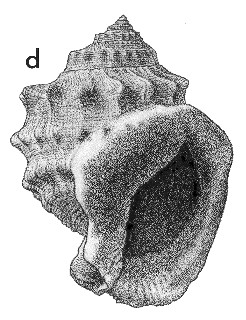
Revised descriptions of New Zealand Cenozoic Mollusca from Beu and Maxwell (1990)

 | Revised descriptions of New Zealand Cenozoic Mollusca from Beu and Maxwell (1990) | 
|
  (Pl. 24d): GS10344, D45/f8483, Calamity Point, Clifden, Altonian (GNS) |
Beu & Maxwell (1990): Chapter 11; p. 222; pl. 24 d.
Synonymy: Cassis muricata Hector 1886, p. 51 (not of Menke, 1828); Euspinacassis pollens Finlay 1926b, p. 230; Phalium (Echinophoria) hectori Abbott 1968, p. 112-114 (new name for Cassis muricata Hector, 1886, preoccupied); Euspinacassis muricata; Galeodea muricata; Phalium (Echinophoria) muricata; Phalium (Echinophoria) pollens
Type species of Euspinacassis Finlay, 1926, synonymised with Echinophoria Sacco, 1896 by Rutsch (1931)
Classification: Cassidae: Phaliinae
Description: Size moderate for subfamily (height 45-70 mm), robust, spire low, about a third total height. Protoconch dome-shaped, of about 3.5 smooth, convex whorls. Teleoconch of 5-6 whorls, sharply angled at or above middle on spire; last whorl with 3 additional angulations, the lowest much weaker than the others; neck short, thick, twisted. Suture typically undulating around tubercles on uppermost basal angulation. Axial sculpture, apart from numerous fine growth lines, appearing on shoulder angle of third whorl as small nodules, quickly increasing in strength to become vertically compressed, subtriangular spines, radial in some shells, directed upwards to some degree in others; typically 7-9 on last whorl but up to 14 on some shells. Last whorl with tubercles or nodules on basal angulations, not as prominent as those on shoulder angle and typically not corresponding in number or position with the latter, those on each row becoming obsolete earlier than on the row above. Suture submargined by narrow band of short growth ridges. Spiral sculpture of very numerous fine threads and threadlets over whole surface, those on anterior part of base noticeably stronger than those above, all finely reticulated by growth lines. Aperture large, heavily armoured; columella almost straight, bearing rather irregular ridges extending within aperture and, in most shells, a much thicker raised fold near middle as well. Siphonal canal short, deeply notched, directed to left and away from aperture, broken on most specimens; fasciole very prominent, of squarish section, margined above by a sharp ridge. Inner lip with very heavy callus spreading laterally over fasciole and forming prominent hollows on either side. Outer lip with heavy varix, inner edge with weak lirae, in many shells obsolete on the posterior half. Most adult shells retaining 1 or 2 previous varices.
Comparison: Echinophoria pollens is the most strongly "armoured" and one of the most spectacular of New Zealand cassids. Powell (1928b, p. 634) distinguished E. pollens from E. muricata (= E. hectori) on supposed differences in the number and disposition of shoulder tubercles, but examination of much larger suites of specimens than were available to Finlay and Powell has shown that these differences are not constant, and that only one species can be recognised. The relationship of E. pollens to other nominal Early Miocene Echinophoria is less clear, however. E. emilyae (Altonian, Ardgowan Shellbed, Oamaru) is somewhat taller-spired than typical E. pollens and has less prominent shoulder tubercles and a thinner parietal callus, but in other respects they are very similar. E. emilyae may merely be a cool-water variant of E. pollens and is probably not worth recognising. Rather more distinctive is the cassid usually called Echinophoria multinodosa, which was described from Motutara, west Auckland (Altonian); this differs from E. pollens in its smaller size (height 35-50 mm), in having more numerous and smaller nodules (13-16 on shoulder of last whorl) and in having more numerous rows of nodules (5 or 6 on last whorl). In the Clifden section, shells of this type are present in the Lillburnian and Waiauan (i.e., succeeding E. pollens). Powell's name unfortunately cannot be used for the New Zealand shells; Cassis multinodosa Speyer, 1863 is an Echinophoria and although it is synonymised with E. rondeleti (Basterot, 1825) by Abbott (1968, p. 97) it must be regarded a secondary senior homonym of E. multinodosa (Powell). We do not propose a replacement name for Powell's species, however, as we consider it conspecific with E. toreuma, also described from Motutara. Another synonym may be E. oneroaensis (Otaian, Waiheke Island).
Echinophoria (regarded as a subgenus of Phalium by some workers) is recorded fossil from Europe, North and South America, Indonesia and Japan, and in the modern fauna (from very shallow waters down to over 1000 m) of Japan, Australia, the Caribbean and East Africa (Abbott 1968). It ranges from at least Duntroonian (possibly Runangan) to Tongaporutuan in New Zealand.
Distribution: Otaian-Clifdenian; Calamity Point Sandstone, Calamity Point, Clifden, Altonian (type locality of E. pollens); Fouraye Siltstone, Long Beach Shellbed and Slip Point Siltstone, Clifden; Pakaurangi Point, Kaipara Harbour, Otaian or Altonian (type locality of C. muricata); Paratoetoe and Te Pokere, Parengarenga Harbour; Puketotara Peninsula, Kaipara Harbour; Awakino Gorge, southwest Auckland. Not particularly common at any locality, but conspicuous because of its size and sculpture.
Cite this publication as: "A.G. Beu and J.I. Raine (2009). Revised
descriptions of New Zealand Cenozoic Mollusca from Beu and Maxwell (1990). GNS
Science miscellaneous series no. 27."
© GNS Science, 2009
ISBN
978-0-478-19705-1
ISSN 1177-2441
(Included with a PDF facsimile file
copy of New Zealand Geological Survey Paleontological Bulletin 58 in CD version
from: Publications Officer, GNS Science, P.O. Box 30368 Lower Hutt, New
Zealand)